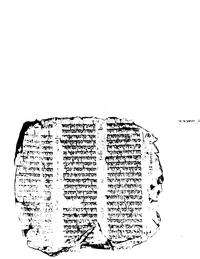Codex Cairensis

The Codex Cairensis (also: Codex Prophetarum Cairensis, Cairo Codex of the Prophets) is a Hebrew manuscript containing the complete text of the Hebrew Bible Nevi'im (prophets). It has been described as "the oldest dated Hebrew Codex of the Bible which has come down to us".[1] It contains the books of the Former Prophets (Joshua, Judges, Samuel, and Kings) and Latter Prophets (Isaiah, Jeremiah, Ezekiel and the book of the twelve Minor Prophets). It comprises 575 pages including 13 carpet pages.[2]
History
According to its colophon, it was written complete with punctuation by Moses ben Asher in Tiberias "at the end of the year 827 after the destruction of the second temple"[3] (this corresponds to the year 895 CE). It was given as a present to the Karaite community in Jerusalem, and taken as booty by the Crusaders in 1099. Later it was redeemed and came into the possession of the Karaite community in Cairo. When the Karaite Jews left Egypt they deposited the codex in 1983, in the Hebrew University in Jerusalem, with document to prove it, where it is kept in a secure room on the floor below the Hebrew Manuscript collection.[4] The Codex was brought back to Jerusalem by a comity of six persons.
Scientific evaluation
Although according to its colophon the codex was written by a member of the Ben Asher family, Lazar Lipschütz and others observed that, within the masoretic tradition, Codex Cairensis seems to be closer to Ben Naphtali than to Ben Asher.
While some scholars consider this to be an argument against its authenticity, Moshe Goshen-Gottstein assumed that Ben Naphtali stuck more faithfully to the system of Moses ben Asher than the latter's own son Aaron ben Moses ben Asher who corrected the Aleppo Codex and added its punctuation.
More recently, further doubts on its authenticity have been cast by radio-carbon dating and other scientific techniques.[5]
Umberto Cassuto relied heavily on this codex when producing his edition of the Masoretic Text, which means that in the prophets his edition is closer to the ben Naphtali tradition than in the Torah or Writings.
Between 1979 and 1992 an editio princeps of the codex (text and masorahs) was published by a team of Spanish scholars. See F. Pérez Castro et alia, El Códice de Profetas de El Cairo, Textos y Estudios "Cardenal Cisneros", CSIC, 8 vols., Madrid 1979-92.
See also
Notes
- ↑ Paul Kahle, "The Cairo Geniza", 2nd ed. 1959, p. 91
- ↑ The City and the Book I
- ↑ Paul Kahle, The Cairo Geniza'(2nd ed. 1959), p.96
- ↑ column by Jerusalem Post columnist and editor J. Zel Lurie.
- ↑ The Hebrew University Bible Project: Ezekiel, p.xli, note 116: "It was recently proven conclusively that the scribe and the naqdan (vocaliser) of the Cairo Prophets codex cannot be identified as Moshe Ben-Asher, and cannot be dated to 895 but rather to the 11th century CE. Cf. M. Beit-Arié et al., Codices Hebraicis litteris exarati quo tempore scripti fuerint exhibentes (Monumenta palaeographica medii aevi. Series Hebraica; Paris/Jerusalem: Brepols, 1997) 25-29; D. Lyons, The Cumulative Masora: Text, Form and Transmission (Beer-Sheva: Ben-Gurion University Press, 1999 [4]-7 (Hebrew).
Sources
- Ernst Würthwein, Der Text des Alten Testaments, Stuttgart 1974 (4th edition), ISBN 3-438-06006-X
- The Hebrew University Bible Project: Ezekiel, ed. Shemaryahu Talmon; pub. The Hebrew University Magnes Press, Jerusalem, 2004; ISBN 965-493-186-9
- Israel Yeivin, trans. E. J. Revell: Introduction to the Tiberian Masorah 1980, ISBN 0-89130-373-1
External links
 Media related to File:Cairo-codex-nevi'im.pdf at Wikimedia Commons
Media related to File:Cairo-codex-nevi'im.pdf at Wikimedia Commons